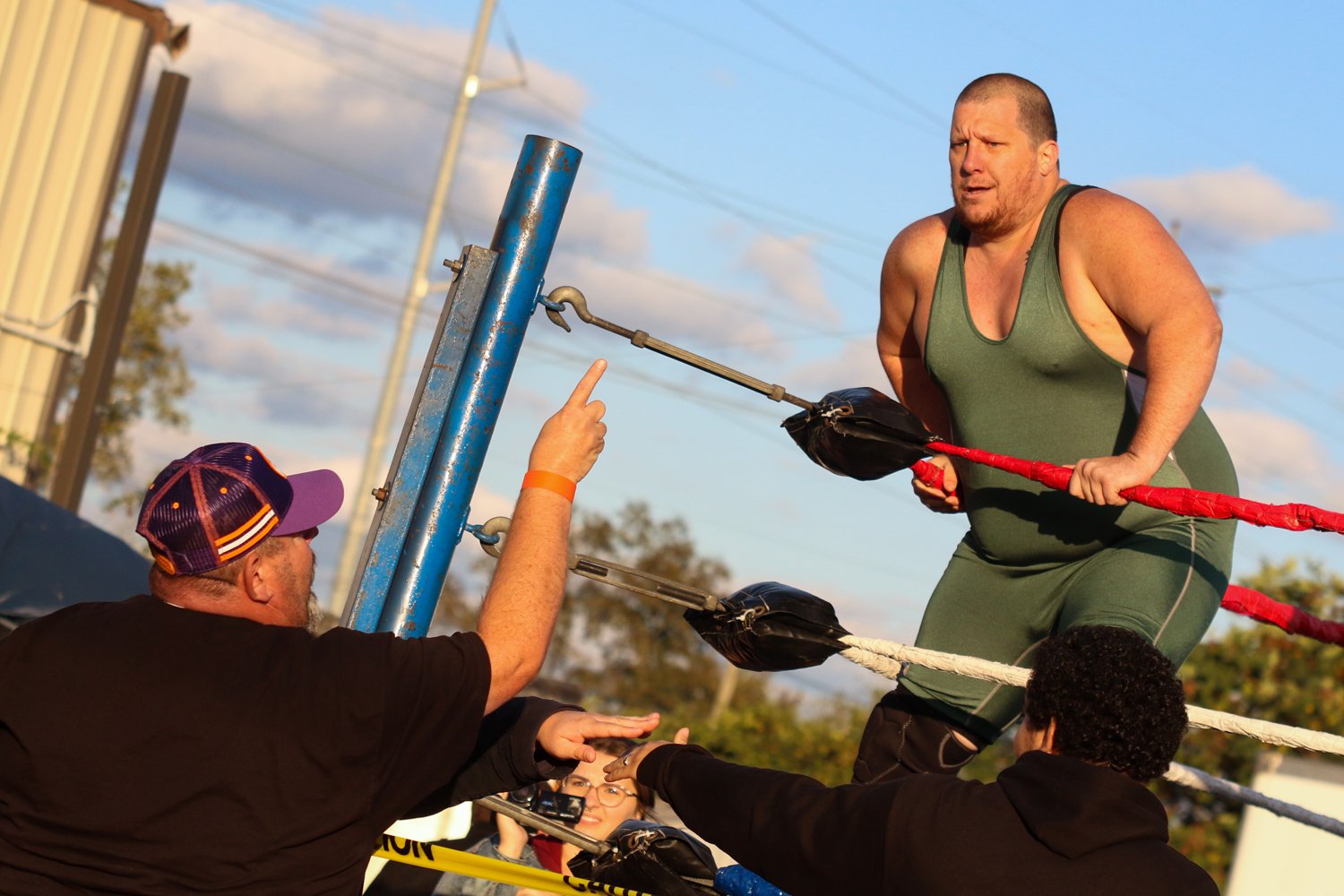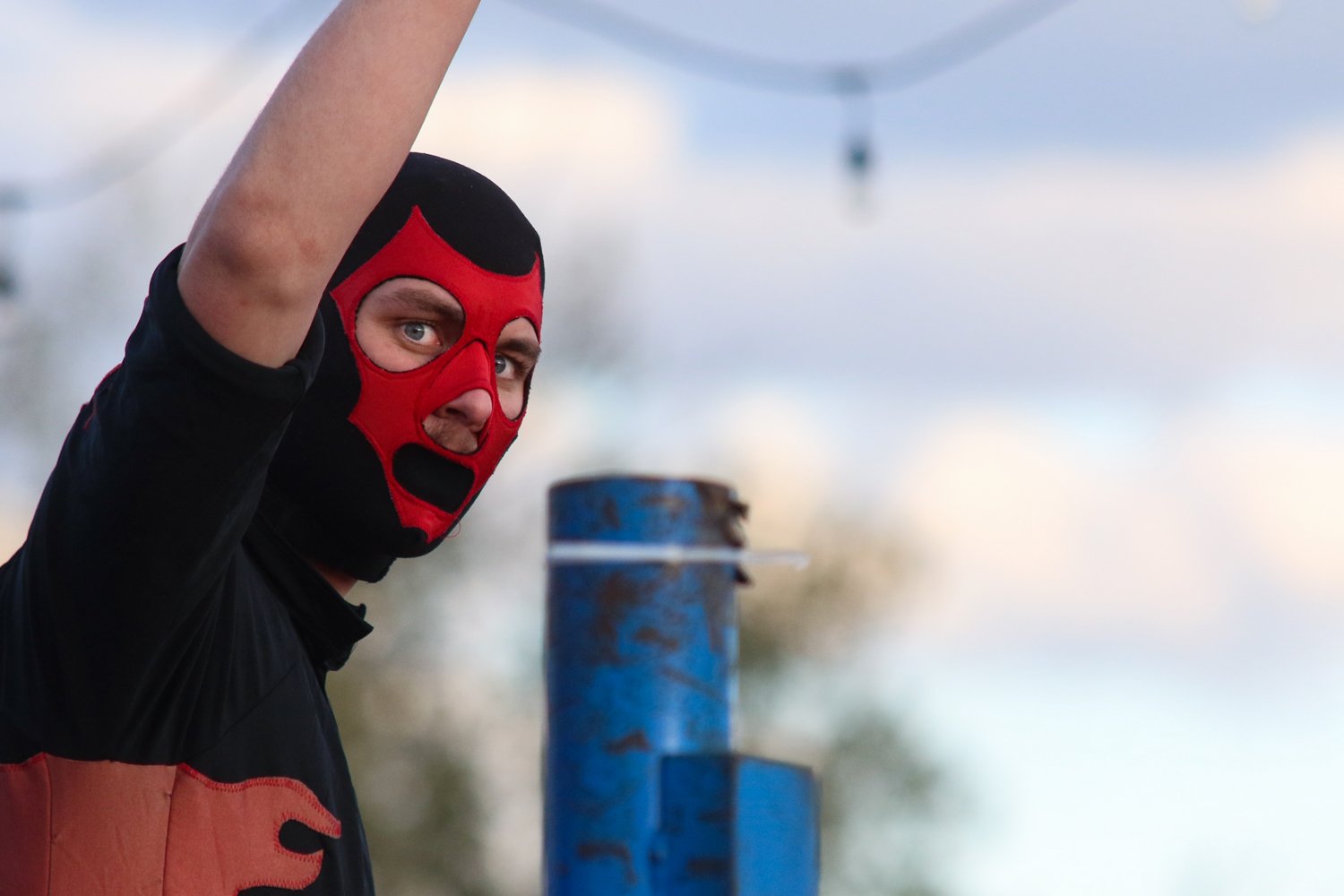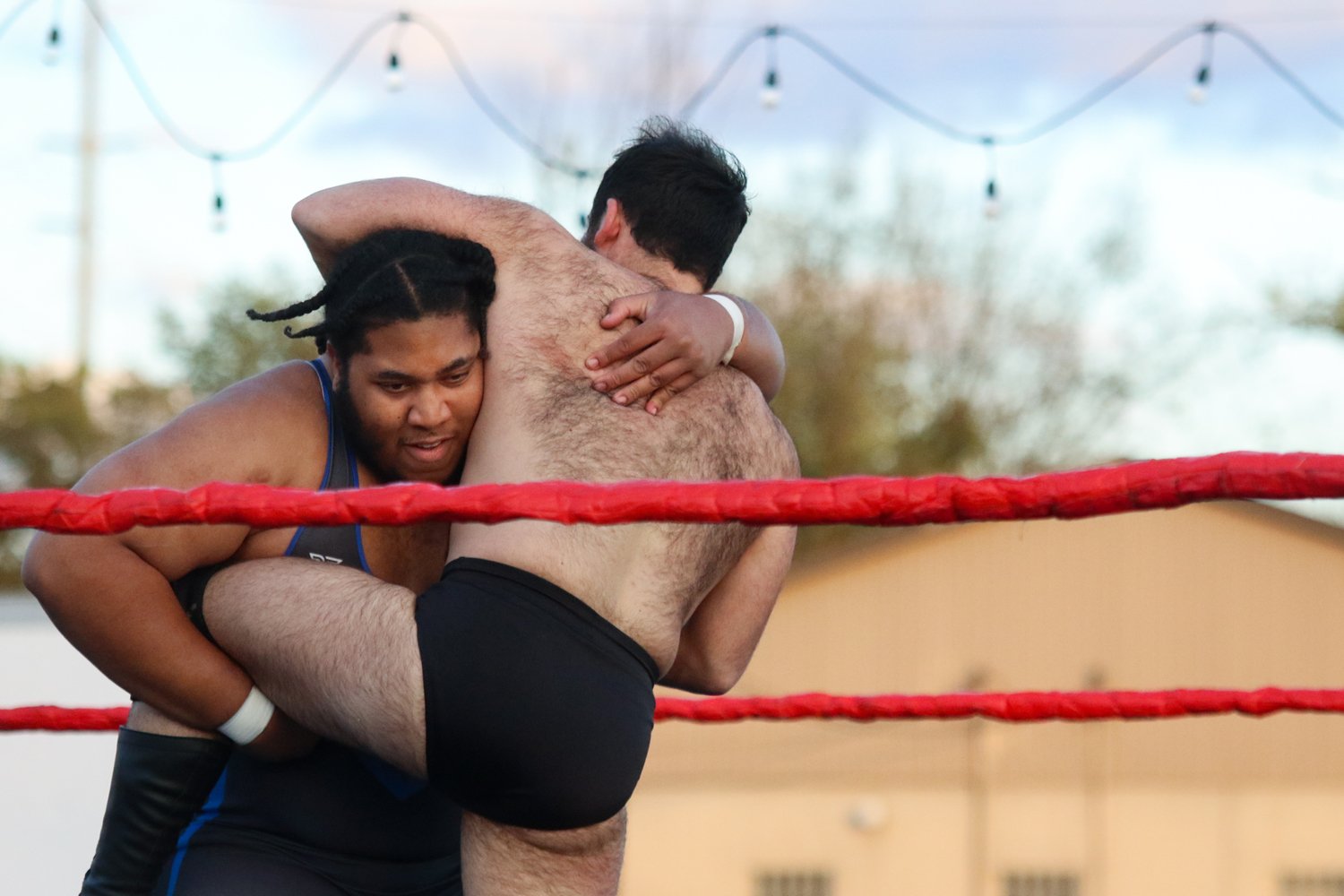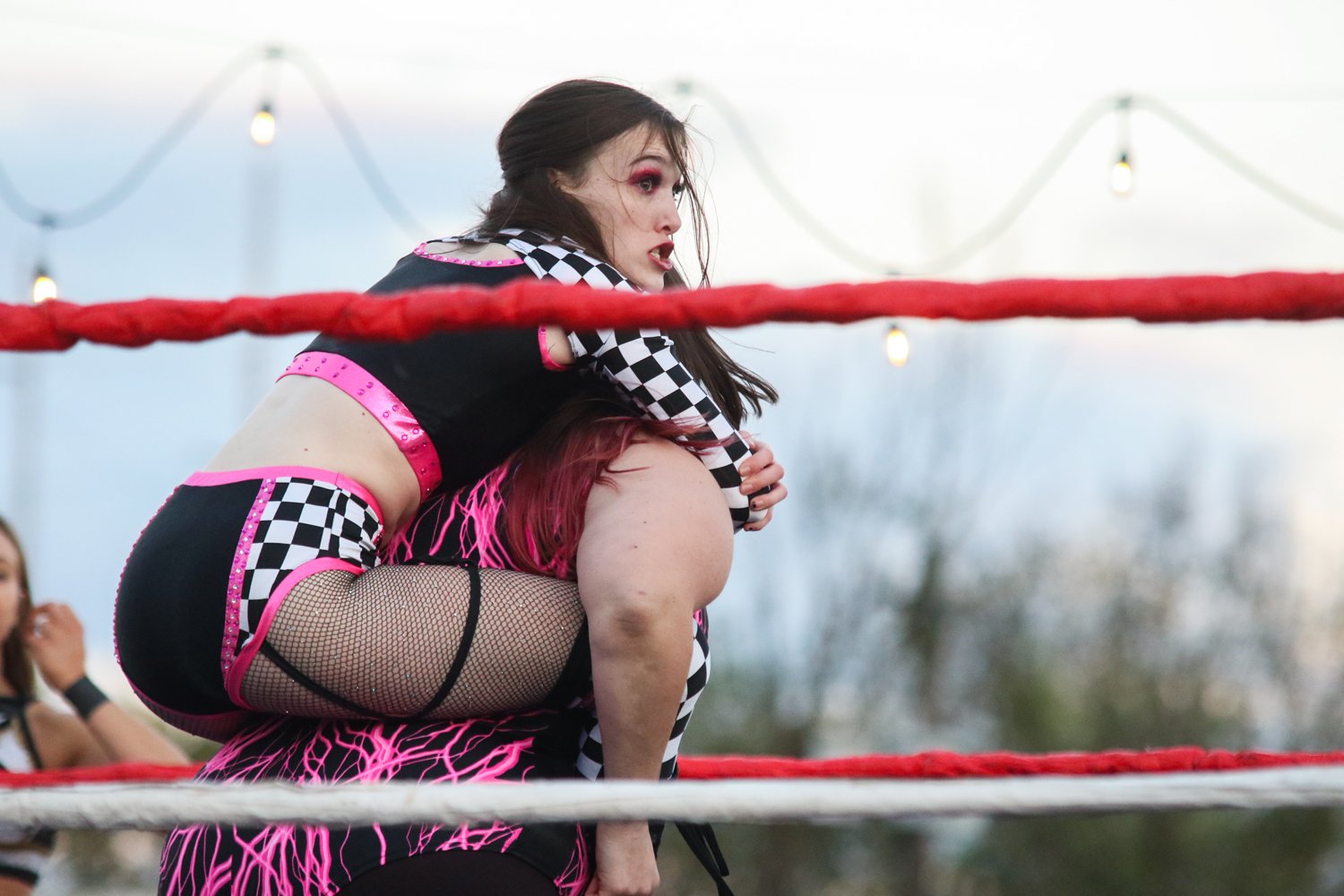20 Years Since Nitro: A Saturday Night at Swine City
Joe Pro James (left) vs. “Headline” Sean Evans (right).
The ropes shake [“whhhhaaaccckk”] and the mat bounces back against the combined force of humanity and gravity [“thhhhuunnnkk”]. Whether it was ten feet away from me in this field, at an arena, or on television as a kid: that sound has always been the same. It is the sound of professional wrestling—more ubiquitous than the promos cut on mics, the pyrotechnics, or the entrance music. It’s heard in nearly every match, from every promotion. Whether they’re local groups charging ten bucks a pop or the top tiers demanding half a c-note for a pay-per-view. One competitor slammed into the center of the ring by another, “whhhaccckk thuuunnkkk” ricocheting into the ears of spectators.
Swine City Brewing in Fairfield, Ohio, hosting the Northern Wrestling Federation on October 16, 2021.
It’s a Saturday night in Fairfield, Ohio. Swine City Brewing operates out of an industrial building near this Cincinnati suburb’s northern border. Craft beer is served in a former garage, pizza is cooked up in what was once someone’s office, and the overgrown lot out back is now a manicured outdoor seating area—one featuring a pumpkin patch on this October weekend. The place is doing steady business, staffed by friendly folks espousing their local libations while the sun sets and pours the day’s last light into the taproom. We’ve made it just in time to grab a few beers and a pair of tickets, passing through the curtain and claiming our seats.
Split-the-pot tickets (we were one ticket away from winning).
You couldn’t ask for a more perfect autumn evening. It’s warm, but with just enough chill to really highlight that Fall is now in full command and summer has retreated…
…Oh, wait, maybe there’s something to that? An analogy of sorts.
Fall has finally defeated its arch-rival: Summer! Winter will snag the title of dominance soon, though, as it always does. Seasons are predictable, much like the storylines of World Wrestling Entertainment.
And how about this location?
Pro wrestling hosted in a blue collar section of town across form the old GM Plant and down the street from the former UAW and VFW halls! Ah, but how does it all tie into our modern cultural conversation?
Do I explore that? Or…do I do what I came here to do? Which is…
…shut the fuck up, sit down, and enjoy this for what it truly is: pure entertainment performed with heart.
“Headline” Sean Evans takes issue with a referee.
Still, while I don’t plan to dig up forced metaphors or dive into sportswriter tropes, I did bring a camera. I wanted to document this experience. I wanted to write something. But, before we get to that: the first bell has rung and “Headline” Sean Evans (who is clearly the bad guy, or, “heel” in pro wrestling parlance), is standing atop a turnbuckle, admonishing my dad for clapping in support of the villain. The evening’s matches have begun!
Joe Pro James (left) vs. “Headline” Sean Evans (right).
“Headline” Sean Evans (top) attempts to pin Joe Pro James (bottom).
Joe Pro James (right) attacks “Headline” Sean Evans (left).
Joe Pro James pins “Headline” Sean Evans for the win.
Joe Pro James celebrates.
Alex Hayden argues with a ringside fan.
A fan laughs at ringside.
Juice watches from the ring apron during a tag match.
Juice takes on The Warlock.
The Warlock pushes Juice into a turnbuckle.
Alex Hayden (top) takes on Juice (bottom).
The Warlock.
Juice moments before being driven into the mat.
Anika taunts the crowd during a match.
Jimbo (right) prepares to slam “Hollywood” Adam Swayze (left).
Jimbo.
Jimbo (left) vs “Hollywood” Adam Swayze (right).
“Hollywood” Adam Swayze (left) applies a hold to Jimbo (right).
Jimbo (left) vs “Hollywood” Adam Swayze (right).
D.C. (left) vs. Dakota Wolfe (right).
D.C.
Riley Matthews on the back of Big Mama.
Big Mama applies a hold to Riley Matthews.
Big Mama receives a kick to the face from Nikki Victory.
Breezy pushes Riley Matthews into the ropes.
Big Mama confronts Riley Matthews in the corner while a referee looks on.
NWF tag-team champions Christopher Michael Lotus and Star Rider pose for a photo during the intermission.
Pompano Joe and Jesse Hyde pose with “superfan” Marshall as their photo is taken by another “superfan,” Andrew.
Jesse Hyde grabs Anika by the nose.
Mr. Reality Check goes on offense against defending NWF World Heavyweight Champion, Rex.
NWF World Heavyweight Champion Rex.
My relationship with pro wrestling is complicated. There’s times I want to embrace it in the same way did as a kid, but it never quite sticks. When I see the “results” of WWE matches covered and analyzed by ESPN in the same vein as traditional competitive sports whose outcomes aren’t dictated by a script—I roll my eyes. But I also want to be very clear here: the folks involved in professional wrestling are undoubtedly athletes and I hold a high respect for them, especially those working the independent circuits such as Cincinnati’s own Northern Wrestling Federation seen here. These folks put on a great show, and after the last bell rang and we paid our tabs—I left smiling in the same way I had 21 years ago when my dad took ten-year-old me to see World Championship Wrestling (Souled Out 2000) at Cincinnati’s downtown arena.
But I’m going to tread lightly here, because I started writing a similar story ten years ago and ditched it. Pro wrestling features a passionate fanbase and I’ve incurred their well-meaning wrath multiple times on both Reddit and Twitter. So let me give some context: I grew up a huge fan of World Championship Wrestling. Even as recess rumors swirled that pro wrestling was “fake,” my faith held strong. Just over 20 years ago on March 26, 2001: I still believed. My eyes went wide at the age of 11 as I tuned in to WCW’s “Monday Night Nitro” program and saw the company’s main competitor, Vince McMahon of the World Wrestling Federation, boasting how he had just purchased his now defeated arch-rival. I was in absolute disbelief—taken aback in the same manner that many Gore voters probably were the year before. I also hadn’t yet realized what exactly the internet was or that it contained fan-run “dirt sheets” that disclosed much of pro wrestling’s backstage drama (such as how WCW had been dying on the vine for months). What made this particular storyline so compelling, even years later as an adult, was that it was an intersection of pro wrestling’s scripted aspects with reality. While Vince McMahon was playing up the purchase with his on-screen “evil” persona, the man had truly made a savy business move. Since 1996, the competition between Ted Turner’s WCW and McMahon’s WWF had launched professional wrestling into the cultural mainstream. Although the war was now over, pro wrestling had reached new heights and exposure. But I was growing up. My interests were changing and many of the performers I loved in WCW didn’t make the jump to the WWF. So I tuned out.
As the years wore on, I’d flirt with professional wrestling now and again. Occasionally, some friends and I would indulge in nostalgia—buying tickets whenever the WWF (now “World Wrestling Entertainment” or “WWE”) was nearby. We saw the “RAW” tv show in Indianapolis once: sucking down beers with indifference as children all around us booed bad guy “CM Punk” who the adults in the audience cheered as a folk hero in wrestling’s newfound “PG” era. Another time, we attend a pay-per-view in Cincinnati, only becoming remotely interested when we couldn’t believe that Ric Flair was still “fighting,” and bleeding, in a cage match at the age of 62. “He’s got another divorce to pay off,” my friend said. The best event I caught over the years since growing up, though? The Northern Wrestling Federation putting on a show in Fairfield, Ohio’s United Auto Workers union hall circa 2011. That was a blast. Those performers were truly into the show for the love of it, so was the audience.
NWF Wrestling at Fairfield, Ohio’s, UAW Hall circa 2011. Photographs made for a story I started writing back then, but eventually abandoned.
What’s intrigued me the most about “sports entertainment” after all this time, however, are the stories that take place behind the scenes. I was enamored with the end of WCW, still wondering how a piece of my childhood could so quickly disappear one Monday night in the Spring of 2001. Then I got those answers thanks to Guy Evans and his definitive book: “NITRO: The Incredible Rise and Inevitable Collapse of Ted Turner's WCW.” It’s a truly fascinating read, an objective look into the business and popular culture of the late 1990s. Even now, I’ll gladly explain the whole saga to anyone who’ll listen. It’s not that important to me, but I still find myself drawn to the story even when I can see eyes glaze over. I’ve even found myself trying to compare and rationalize the drama of professional wrestling storylines to that of modern theatre. Maybe that’s fair, maybe it’s not, but I will say this—I’ve met plenty of theatre-savvy folks who could learn a thing or two from the performers in “the squared circle.” Shakespeare’s work isn’t inspiring multiple weekly shows on basic cable.
When it comes to those weekly television shows these days, I can’t stomach more than a few minutes. Nor do I have an interest anymore when the big promotions roll into town, but hell—I’ll binge all of Vice’s “Dark Side of the Ring” in one weekend and gladly go down Wikipedia rabbit holes about “Rowdy Roddy Piper” while waiting for the train. Professional wrestling still has this hold on me in the same way other nostalgic parts of my life do. I often find that my conflicted emotions about “sports entertainment” can reflect other parts of my being. Even if I’m not ten years old anymore watching “Harlem Heat” in a tag team match, I’m still very much a person trying to figure out what worlds I exist in—caught between the kinds of spaces where one feels they truly belong and where they don’t. But none of that really came to mind in a pumpkin patch behind a suburban brewery on a Saturday night. No, that night was just fun. Pure entertainment put on by good people who made an audience smile. And I think I’ll go watch the NWF again the next chance I get.
You can learn more about the Norhtern Wrestling Federation and see their upcoming list of events here.
Special thanks to Kirk Shephard for his assistance with this story.
Since 2007, the content of this website (and its former life as Queen City Discovery) has been a huge labor of love.
If you’ve enjoyed stories like The Ghost Ship, abandoned amusement parks, the Cincinnati Subway, Fading Ads, or others over the years—might you consider showing some support for future projects?




































